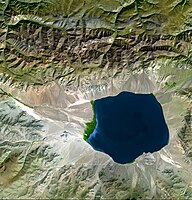
Photo from wikipedia
This study aims to quantify sources and sinks of phosphorus (P) in the small mountainous river (SMR)-sea system in southwestern Taiwan. The Gaoping River (GP) exported total phosphorus (TP) at… Click to show full abstract
This study aims to quantify sources and sinks of phosphorus (P) in the small mountainous river (SMR)-sea system in southwestern Taiwan. The Gaoping River (GP) exported total phosphorus (TP) at 1.08 × 109 mol year−1 into the GP coastal sea, corresponding to a global highest TP yield of 3.28 × 105 mol km−2 year−1 from the watershed during the study period. The river water TP comprised of 98.2% particulate P (PP) and 1.8% dissolved P. The PP was associated mainly with 10–63 μm particles and comprised 92.5% particulate inorganic P (PIP) and 7.5% particulate organic P (POP). The river flux of TP (or TP yield) was primarily determined by the sediment load which in turn was driven by river discharge varying with local climate variability. In the GP coastal sea, sedimentation rates decreased gradually with water depth, ranging from 0.032 to 1.62 g cm−2 year−1, and the highest rates were located on both sides of the GP Canyon, likely the result of typhoon impacts. The burial fluxes of the PP ranged from 0.02 to 0.84 mg cm−2 year−1, comprising approximately 88% PIP and 12% POP. The total deposition rates of sediment and PP were approximately 6.6 × 106 t year−1 and 4227 t year−1, respectively, in the study area, if integrated over an area of 3045 km2, with a maximum water depth of 1500 m. The burial efficiency of PP in the GP coastal sea ranged from 44 to 95%, which decreased generally with sampling location depth. A budget model showed that the imbalance of P sources (1.08 × 109 mol P year−1) and sinks (1.36 × 108 mol P year−1) implies about 90% of river inputs being recycled or exported out of the study area. The SMR margin that is associated with the canyon may act as an efficient conduit in transporting TP across the narrow margin into deep oceans.
Journal Title: Estuaries and Coasts
Year Published: 2018
Link to full text (if available)
Share on Social Media: Sign Up to like & get
recommendations!